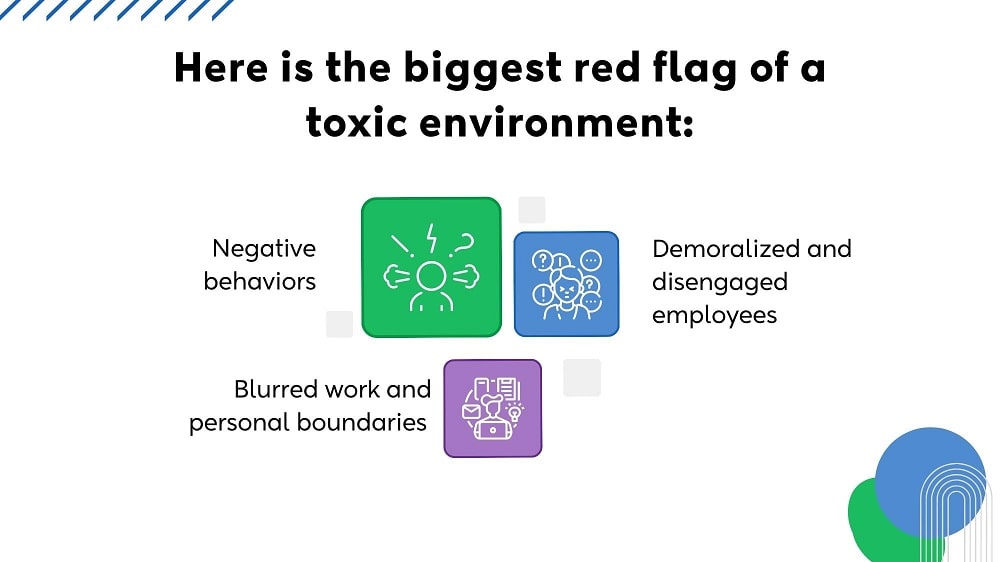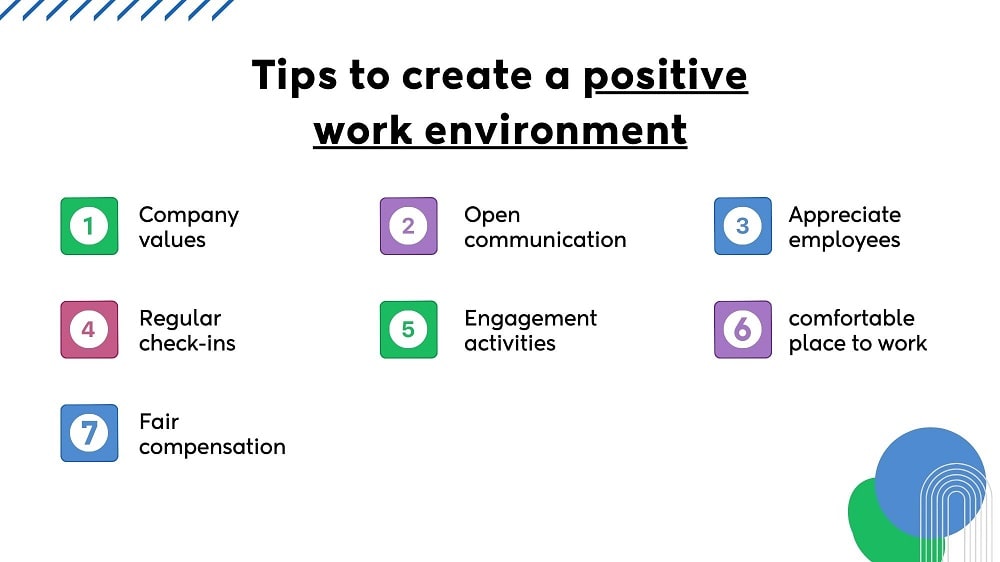Toxic company culture is the No. 1 reason 33% of employees in the U.S. are considering quitting their jobs, while 25% have actually resigned over the past six months.
Before you jump into tips and tricks to create a positive work environment, let’s just first talk a little about the toxic work environment because most people don’t even know what it looks like or often have the wrong idea about it.
Executive and leadership coach Lisa Quinn says, “Sometimes it feels hard to know if you have a toxic work environment because you just assume that such environments are normal.”
Here is the biggest red flag of a toxic environment:
If your employees are afraid to walk to management and raise concerns or say anything about the things that are not going well because they fear they will be fired, cornered, or bullied, believe me, you have a toxic work environment.
You can create a positive work environment only when you clearly know what is going wrong. And you can only find what is going wrong when in the first place you detect it.
In this post, I will talk about the signs of a toxic work environment, tips to create a positive work environment, and the importance of a positive work environment.
Signs of a toxic work environment

There are some common signs found in toxic workplaces. They tell you that things are not going well. It is hard to mention every sign, but a few signs are sure-shot signals of a toxic work environment.
1. Negative behaviors
Manipulation, bullying, discrimination, favoritism, nepotism, micromanagement, and gaslighting are some of the negative behaviors that undermine the trust among employees and management.
How to detect these signs?
You can easily identify these signs by monitoring how your employees treat each other and their interpersonal relationships with managers.
For example, if you hardly find your employees smiling and chit-chatting together while brewing coffee or often spending more time scowling and typing on their smartphones, you know things are not going easy in your company.
Read more: Learn How to Create a Safe Space at Work!
2. Demoralized and disengaged employees
If you find your employees demoralized and disengaged at work, just trying to perform minimum to save their job because they need money, and refusing to actively participate and take responsibility for their actions, these are clear signs that there are dire problems with your company’s work culture.
If it continues for long, your employees will leave your organization the moment they get an opportunity.
If you need a quantifiable measure, look at the turnover rate of your company. If most of your employees are leaving within 12 months of joining, it is a sign your company has a bad work environment.
3. Blurred work and personal boundaries
Live to work or work to live. Being in a senior or C-level position, you might think it is okay to put in extra effort and stay late in the office. But you cannot push your employees to work after hours or be available all the time.
This will lead to mental exhaustion and burnout because employees are not able to relax. If you see your employees coming to the office tired, overstressed about work, working after hours, not being able to switch off from work, and taking a large number of sick leaves, it is a sign of work stress.
If you do not have any of these signs at your organization, congratulations you have made your organization toxicity-proof. But if you smell these signs, you can fix the toxic work environment with the tips mentioned below.
Tips to create a positive work environment

The first step to creating a positive work environment is to find where the problem lies. A variety of reasons can lead to a toxic work environment, such as poor company values, a small group of toxic employees, circumstances of the company, unrealistic expectations, or something else entirely.
It is hard to tell what is causing trouble for you unless one analyzes the entire process, but I can definitely help you with the groundwork to help you create a positive work environment.
1. Company values
The company culture originates from company values. And company values define your vision and what you stand for. First of all, lay out the core values of the company.
Clearly define what kind of company culture you want to build. Learn about the top practices adopted by the best companies to work in the world.
Sit with all the stakeholders, leadership, long-term employees, and HR representatives to lay out the core values that reflect your company culture.
Receive feedback from your employees to find out what values they want to see in the company culture. This will help you create company values that are aligned to serve the company culture you envisioned and the long-term goals.
2. Open communication and the right response
I talked about the biggest red flag of a toxic work environment in the beginning. It says employees are afraid to raise concerns to management because they fear they will be fired or cornered.
It happens because of two reasons: first employees do not have open lines of communication with higher management and second the management has not received and responded to the criticism positively and appropriately. Thus, they lose trust in the management.
Now, all you need to do is the reverse. Create an environment where employees can walk to the management anytime and feel psychologically safe to open up about any issue they are facing.
Employees who feel their voice is heard are 4.6 times more likely to perform their best work.
It can happen only when you respond appropriately. Rather than blaming employees for the issue, appreciate that they bring issues forward and try to find solutions based on the facts, reasoning, and your company values.
3. Appreciate employees
With the above two things in place, you can protect your company from toxicity. But to create a positive work environment, you need to go a little further.
80% of employees say they’re motivated to work harder when they’re recognized for their work by their superiors.
At the same time, 66% of employees would leave their jobs if they didn’t feel appreciated.
Thus, you can clearly see the importance of appreciating your employees because sometimes all is going well, it is just that employees need appreciation and recognition to feel belonging and satisfaction with their work.
A survey shows strong employee recognition programs reduce turnover rates by 31%.
4. Regular check-ins
Creating a positive work environment is not a one-time effort. You have to make consistent efforts. Moreover, a part of your company culture. And it is not very difficult. A regular check-in daily, biweekly, or weekly whatever works for you can do wonders for you.
During regular check-ins just ask your employees how things are going, listen to them, and provide assurances if required. It is a great way to build connections with your employees and send them the message you care about them.
An HBR study shows, 46% of respondents said the most successful managers checked in frequently and regularly with remote employees.
Similarly, 89% of HR leaders agree check-ins are key for successful outcomes.
5. Engagement activities
Employees’ expectations have changed a lot in today’s time. It is not just about the salary alone. Employees want to work at a workplace where they feel emotionally satisfied and enjoy working.
That’s why you will see the increasing trends of organization-wide engagement activities hosted by companies from time to time to create a work environment where employees feel emotionally satisfied.
Engagement activities provide opportunities for employees to make social connections, unwind from work, express themselves, and explore their personalities.
This sends employees a message that they mean more to the company than just completing work on time.
6. Make your office a comfortable place to work
Career coach Eli Bohemond says, “You can pick up on the energy of a workplace through the general ambiance and body language of individuals.”
Little things like furniture, lighting, working equipment, cleanliness, pantry area, and activity rooms can make a great difference in your company’s work environment. A clean and comfortable workplace is attractive to everyone.
A simple thing like adding living green plants to your workspace can lift the spirit of the place. It helps reduce stress and lift the mood of the employees.
Many companies have added bean bags and standing desks to provide more agility to the workplace.
7. Fair compensation
You have strong company values, great work culture, and decent office infrastructure, but if you are intentionally underpaying the employees, employees can leave your organization.
Fair compensation is a key component of a positive work environment because when employees have financial safety, they tend to work better, have better work-life balance, and refrain from negative attitudes towards the company.
I hope these tips help you lay the foundation of a positive work environment for your organization. And the important thing is creating a positive work environment is not just about being nice. It has fruitful results for organizations.
Importance of a healthy work environment
A healthy work environment is not only good for employees but also offers a vast range of benefits for an organization. Have a quick look at them.
➡️ Improved performance: A positive work environment links to increased job satisfaction which in turn encourages employees to do better. They perform at their best potential to achieve the company’s goals and have a positive attitude towards work.
➡️ Reduced turnover: Everyone cherishes working in a positive workplace. A Glassdoor survey of over 5,000 workers from the United States, United Kingdom, France, and Germany found that 56 percent of respondents prefer a good workplace culture over salary for job satisfaction. Thus, employees are less likely to leave an organization with a positive workplace environment.
➡️ Reduced absenteeism: Studies show that happy employees show up to work every day with passion, purpose, and energy. A highly engaged work environment leads to a 41% reduction in absenteeism. This results in increased productivity, lower sick leaves, and higher profits for organizations.
➡️ Enhanced creativity: A positive work environment provides ample space and psychological safety for employees to share their ideas with management. They go to extra lengths when they feel connected to work and pursue work with a passion that helps companies improve the quality of products and services.
➡️ Increased profit: If you look at the end results of the effects of a positive work environment whether it is reduced turnover, increased productivity and efficiency, or improved product quality, it is a financial benefit. Just take an example of a reduced turnover rate. It helps you save money on finding and hiring new employees by retaining existing talent for a long time. Thus, you can make indirect financial gains with a healthy work environment.
Wrapping up
It is no secret that a positive work environment is a key ingredient of success because when employees are happy, amazing things can happen to the business. Happy people are the best people.
The only question is how to create a positive work environment so that you can make the most of its known and unknown benefits.
We have learned and understood that with the right practices, systems, mindset, culture, and execution in place, an organization can create a positive work environment.
Keep in mind it is a long process and change is not going to happen overnight. But, it is worth investing time, money, and effort.

















No Comments